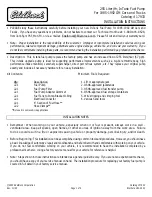
engine failure. Therefore, if you frequently
drive short distances, you should take a 20
minute trip on a motorway or rural road at
least every 500km.
Braking
Important safety notes
G
WARNING
If you shift down on a slippery road surface in
an attempt to increase the engine's braking
effect, the drive wheels could lose their grip.
This increases the risk of skidding and having
an accident.
Do not shift down for additional engine brak-
ing on a slippery road surface.
Downhill gradients
On long and steep downhill gradients, espe-
cially if the vehicle is laden or towing a trailer,
you must select shift range
1, 2 or 3
This will use the braking effect of the engine,
so less braking will be required to prevent the
vehicle from gaining speed. This relieves the
load on the brake system and prevents the
brakes from overheating and wearing too
quickly. If you need additional braking,
depress the brake pedal repeatedly rather
than continuously.
Heavy and light loads
G
WARNING
The braking system can overheat if you leave
your foot on the brake pedal while driving.
This increases the braking distance and could
even cause the braking system to fail. There
is a risk of an accident.
Never use the brake pedal as a footrest. Do
not simultaneously depress both the brake
pedal and the accelerator pedal while driving.
If the brakes have been subjected to a heavy
load, do not stop the vehicle immediately, but
drive on for a short while. This allows the air-
flow to cool the brakes more quickly.
If the brakes have been used only moderately,
you should occasionally test their effective-
ness. To do this, brake more firmly from a
higher speed. This improves the grip of the
brakes.
Wet road surfaces
If driving in heavy rain for a prolonged period
of time without braking, there may be a
delayed reaction from the brakes when brak-
ing for the first time. This may also occur after
the vehicle has been washed.
You have to depress the brake pedal more
firmly. Maintain a greater distance from the
vehicle in front.
After driving on a wet road or having the vehi-
cle washed, brake firmly while paying atten-
tion to the traffic conditions. This will warm
up the brake discs, thereby drying them more
quickly and protecting them against corro-
sion.
Limited braking performance on salt-
treated roads
If you drive on salt-treated roads, a layer of
salt may form on the brake discs and pads.
This can increase the braking distance con-
siderably.
R
Apply the brakes occasionally in order to
prevent any salt build-up. Ensure that you
do not endanger other road users when
doing so.
R
Carefully depress the brake pedal at the
end of the journey and when starting the
next journey.
R
Maintain a much greater distance to the
vehicle in front.
New brake pads/linings
New brake pads/brake pads and discs that
have been replaced only achieve optimum
braking effect after several hundred kilome-
tres of driving. Compensate for the reduced
102
Driving tips
Driving and parking
Содержание G-Class
Страница 1: ...G Class Owner s Manual Nur f r internen Gebrauch For internal use only...
Страница 4: ......
Страница 19: ...Cockpit 18 Instrument cluster 19 Centre console 21 17 At a glance...
Страница 50: ...48...
Страница 51: ...Useful information 50 Correct driver s seat position 50 Seats 50 Mirrors 55 49 Seats steering wheel and mirrors...
Страница 58: ...56...
Страница 78: ...76...
Страница 86: ...84...
Страница 128: ...126...
Страница 129: ...Useful information 128 Loading guidelines 128 Stowage areas 129 Features 136 127 Stowing and features...
Страница 141: ...Useful information 140 Engine compartment 140 Service 145 Care 147 139 Maintenance and care...
Страница 154: ...152...
Страница 174: ...172...
Страница 188: ...186...
Страница 205: ...203...
Страница 206: ...204...
















































